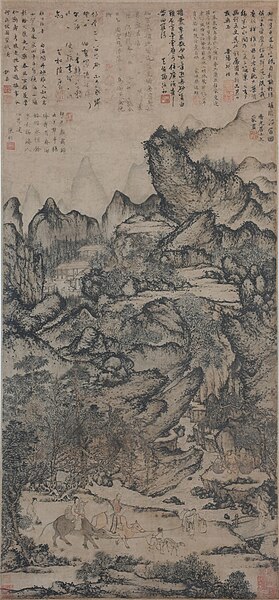Moving Zhichuan

|
| Moving Zhichuan |
|---|
| Wang Meng , around 1360 |
| Ink and color on paper |
| 130 × 35.5 cm |
Moving Zhichuan (葛 稚 川 移居), also called Zhichuan Relocating , is a scroll painting by the Chinese painter and calligrapher Wang Meng .
The landscape painting, created around 1360, is an ink painting . It depicts the move of the family of the poet, Dao priest and alchemist Ge Hong - nickname or courtesy name ( zi ( 字 ) or tseu , or biaozi ( 表字 )), Zhichuan - to the Luofu Mountains . The move to Luofu, where Zhichuan died around 340, marks the end of his public service.
A scroll painting of the same name with ink and color on paper in the format 139 × 58 cm hangs in the Palace Museum in Beijing.
Provenance
The hitherto unknown painting from a private collection was sold to an unknown bidder on November 5, 2011 for $ 62.11 million in the Poly Spring Auction Ancient Calligraphy and Painting in Beijing. The Poly Auction House, which auctioned Wang Meng's paintings, specializes in Asian art. The company, which only started operations in 2005, is currently the third largest auction house in the world after Christie's and Sotheby’s .
description
The scroll painting shows a richly structured high mountain landscape, dramatically towering, partly bare and steep rock formations as well as meadows, wooded hills and groups of trees. In the lower quarter of the picture there is an expanded group of five people, two of whom are sitting on mighty mounts. Almost the entire upper quarter of the picture is densely covered with calligraphy. The owner's red stamps are carefully placed on the edges of the picture or below the calligraphy, without covering any painting or writing.
Wang Meng
Wang Meng came from a family of artists. He was the grandson of the famous painter and calligrapher Zhao Mengfu and his wife Guan Daosheng (1262-1319), who was also a painter. Wang Meng served in a subordinate position in both the Yuan and Ming Governments. When he was wrongly suspected of cooperating with the Prime Minister Hu Weiyong (胡惟庸) († 1380), who conspired against the Ming emperor Hongwu , he was locked in prison for the last five years of his life.
Wang Meng was friends with the painter Ni Zan (倪 瓚, 1301–1374), who, like Wang Meng, is one of the Four Masters of the Yuan period , but who preferred to lead a contemplative life as a monk rather than a ruler to serve Mongolian yuan.
Ge Hong
Ge Hong was born in 283 into a wealthy magnate family. After his family lost their fortune during the unrest in China, he initially made a living by copying books. He studied the Confucian classics, came into contact with followers of the Dao and began to deal with the subject of immortality, which would occupy him for the rest of his life.
He served in the military for a while, was skilled with a bow and arrow, and put down a riot at the age of 20. In 305 he had the rank of general. After his patron and sponsor passed away, he resigned from military service and spent the next eight years of his life in seclusion in Luofu. During his stay in the Luofu Mountains, he initially had four huts built, which were later gradually expanded into temples: in the north the Temple of the Great Void , in the west the Temple of the Yellow Dragon , in the east the Temple of the Nine Heavens and in the north the Temple of Ecstasy (or Temple of Junkets ). During this time he wrote his magnum opus , a two-volume work entitled: "The Inner Chapters of the Master Who Embraces Simplicity" and "The Outer Chapters of the Master Who Embraces Simplicity".
literature
- Yang Xin, Richard M. Barnhart, Nie Chonghzeng, James Cahill, and others. a .: Trois mille ans de peinture chinoise . Arles: Piquier 2003. pp. 175f. ISBN 2-87730-667-4
- Wang Meng. The Migration of Ge Zhichuan . Chinese edition. Hunan Fine Arts Publishing House 2013. ISBN 7-5356-5872-5
Web links
- Chinese Spring Auction 2011
- Wang Meng painting auction for $ 62 million, China.org.cn
- The Simple Retreat. Ge Zhichuan Relocating.
- Persons in Chinese History - Ge Hong 葛洪; Chinaknowledge.de
Individual evidence
- ^ Everything2 Chinese courtesy name , accessed August 18, 2015.
- ↑ 10 Most Expensive Chinese Painting and Calligraphy Artworks in 2011 , accessed May 20, 2019
- ↑ Barbara Pollack: China's Growing Auction Giant Artnews, October 21, 2013, accessed November 29, 2016
- ↑ Wang Meng, Yuan Dynasty , accessed December 2, 2016.
- ↑ Temple of ecstasy (Sulaoguang), Guangdong , accessed on 3 December 2016th
- ^ Ge Hong (Ko Hung, 283-343 CE) Internet Encyclopedie of Philosophy, accessed December 2, 2016